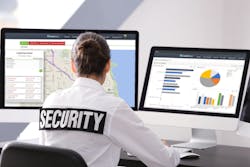Maintain superior service with offsite security supervision
Due to an escalation in the number and type of security threats to businesses, as well as growing public demand for the protection of everyday activities, the security guard services industry is experiencing solid growth. The Bureau of Labor Statistics predicts a five percent increase in the number of guard jobs through 2024, up from an already impressive 1.15 million employed guards.
Why such high demand? As more government and corporate entities realize they need to protect their assets, including facilities, goods, and data, they are striving to proactively employ professionals who know how to best reduce risk. Approximately 8,000 U.S. security guarding companies serve all the needs of the U.S. market, but surprisingly the top 50 security firms hold over 75% of the market, with an estimated value of approximately $27 billion.
The security guarding market, particularly at the enterprise level, is highly competitive. Many large security companies operate on tight profit margins, placing them under pressure on several fronts. They must be able to source and retain customers, find failsafe methods to enhance service delivery, meet service level agreements, protect their clients and their assets--and remain profitable.
For many security companies, the key solution lies in one of the critical links on the manned guarding value chain: the security supervisor. While several client requirements still necessitate keeping a security supervisor on-site, many larger security companies are now realizing economies of scale by cutting back on middle management costs. These companies are adopting a remote management model for the growing number of their customer sites that do not require a security officer’s supervisor to have a physical presence onsite.
Remote management entails equipping a security supervisor with the capabilities to oversee numerous teams of security officers at multiple sites, allowing them to get the most out of their teams. It also requires security companies to compete where it matters most: price, without compromising the quality of service. How then, can modern contract security companies continue to balance increasing standards with the need to compete on value?
Transitioning managers to a remote supervisory role can combine the best of both worlds. Maintaining a responsive onsite security officer presence while managing from a remote location can not only provide the same level of security for the price, it can often improve it and do it at a lower cost from an operational cost and manpower perspective.
Here’s why competitive contract security companies are using remote supervision, what it means for forward-thinking managers, and why operating leaner doesn’t have to compromise your highest security standards or quality of service:
What is “Remote?”
A few years back, before technological advances enabled more centralized security officer monitoring and management, security supervisors were stationed onsite at each customer location or traveled to visit a variety of sites. Security companies had a supervisor who was less remote, more local, and traveling, leading to unproductive time spent in a more administrative position rather than in a proactive, supervisory, and strategic function.
Today we have other options. Supervisors can now work from any location, provided they have the right monitoring tools, giving them a bird's eye view of the entire operation, or of multiple sites if needed. Activities are tracked in real-time, including shift start and end times, reported events, and location of guards on the field. Remote managers can be in the next building, another city, or another state without losing control of security officers or visibility of customer sites. Depending on contract requirements, the capability to gather data by an officer, through video, photos, and GPS position allows for a powerful tool that can monitor from one to a thousand sites from a single, secure location.
Moving to a remote management environment delivers more than just a technical upgrade, however, as cost-saving and revenue growth measures can accrue. When a security company bids on a contract knowing they can accomplish more with fewer supervisors, they can often bid lower than the competition, without sacrificing any deliverables or quality of service. Too often, contracts are granted based on price. A remote management factor helps level the playing field for security teams who want to maximize their human capital without sacrificing any industry standards.
Going Remote is More Than Just Tools and Pricing
Remote systems support more economical use of resources and can help security companies realize growth. But the benefits don’t end there. Using technology and data-driven solutions grants access to two important components of security guard technology: business intelligence and data analytics. These often-overlooked components create a more comprehensive view of how a contract is being met, and they support a more proactive approach toward security--resulting in actionable insights that yield a higher overall strategic value for the client.
With your remote security manager continually monitoring the site, there’s considerable leverage at your disposal. A remote command center lets you see what’s going on live, but it also uses that data and analyzes it to determine ongoing and potential future threats. Even with reports filled out by officers, automation processes can kick in when the remote system identifies a threat and it is confirmed by the manager. Rather than waiting on a passive reporting system and a chain of command, technology can identify trends in reporting and alert supervisors to potential risks or threats that require prompt action.
The Business Advantages
Witnessing the benefits of a remote security management scenario without compromising on quality and customer service often prompts modern security guarding companies to explore the remote management model for themselves. While many of these companies may be tempted to view a remote monitoring capability as a ‘new service,’ there is also a strong business perspective to consider for this migration.
Security companies operate at peak efficiency, looking for every opportunity to lower contract pricing, and not only keep bids viable, but keep competitors at bay. The remote security supervisor could easily give security companies a unique business opportunity that contributes significantly to customer retention, thereby reducing customer churn. By virtue of offsite technology, supervisors can optimize the resources at their disposal from both officers and an equipment perspective, for a customer site or manage a specific scenario.
The newer technology also offers greater oversight of guards, and if any issues or challenges require an escalation, relevant managers are notified instantly. In addition, security supervisors are monitored by their managers, bringing a greater level of oversight and speedier resolution of issues. As the future of security moves toward a more efficient tech-based system, the technology will empower offsite supervisors to provide reports to customers based on their requirements, deliver greater customer transparency, enhance customer communication, and ultimately build better customer relations and client retention.
The process for a security company to establish offsite security supervisor capabilities is seamless. Having this capability and value proposition in place creates a solid framework on which to implement services for new clients. This reduces new client lag time, ensures security officers are correctly managed from the first day on the job, and provides actionable intelligence that can be dealt with in the appropriate way. Clearly, remote supervisor capabilities provide a competitive advantage and add significant business value to security companies at all touchpoints of business.
Making a Move? Here’s What to Expect
Shifting from onsite to remote management entails more than moving a team member to another location or equipping them with state-of-the-art monitoring tools. It also simplifies clunky administrative processes and streamlines them for management teams. Much of what security supervisors do today is administrative: compiling reports, making recommendations, checking on HR functions (such as certification and shift changes.) All these tasks are still important and are usually required in some capacity by the client contracts and industry compliance standards.
By digitizing and removing the old-fashioned paper-based reporting functions and automating many of them-- a handsome perk of fully utilizing remote systems--supervisors can be freed up to do what they do best, such as communicating with security officers and being prepared and responsive so the worst doesn't happen. Creating a leaner and more focused security management force is the key driver behind a move to remote.
The future of security guards is here. Companies of all sizes are reaping the benefits of transitioning supervisory roles to a remote position and delivering job functions via a secure solution. Professional and well-trained guards and supervisors will always be required to ensure that sites and their assets are well-protected and that customers feel well served. With the more robust remote tools available today, however, this same protection can provide more value to the customer and fully utilize data-based solutions that take more of the busywork out of managing frontline teams.
About the author: Manuel Mestré is Vice President of Customer Success for Trackforce Valiant, a leader in complete security workforce management solutions. More than 300,000 professionals at over 30,000 customer sites in 45 countries use Trackforce Valiant every day to ensure the delivery of reliable security services, improve operational efficiency and optimally manage their human capital. For nearly 30 years, Trackforce Valiant has provided fully integrated security solutions to its partners and customers. Additional information is available at http://www.trackforce.com or at http://www.valiant.com/
About the Author

Manuel Mestré
Vice President of Customer Success for Trackforce Valiant
Manuel Mestré is Vice President of Customer Success for Trackforce Valiant, a leader in complete security workforce management solutions. More than 300,000 professionals at over 30,000 customer sites in 45 countries use Trackforce Valiant every day to ensure the delivery of reliable security services, improve operational efficiency and optimally manage their human capital. For nearly 30 years, Trackforce Valiant has provided fully integrated security solutions to its partners and customers. Additional information is available at http://www.trackforce.com or at http://www.valiant.com/

